load capacity DODGE DURANGO 2022 Vehicle Warranty
[x] Cancel search | Manufacturer: DODGE, Model Year: 2022, Model line: DURANGO, Model: DODGE DURANGO 2022Pages: 200, PDF Size: 6.72 MB
Page 6 of 200
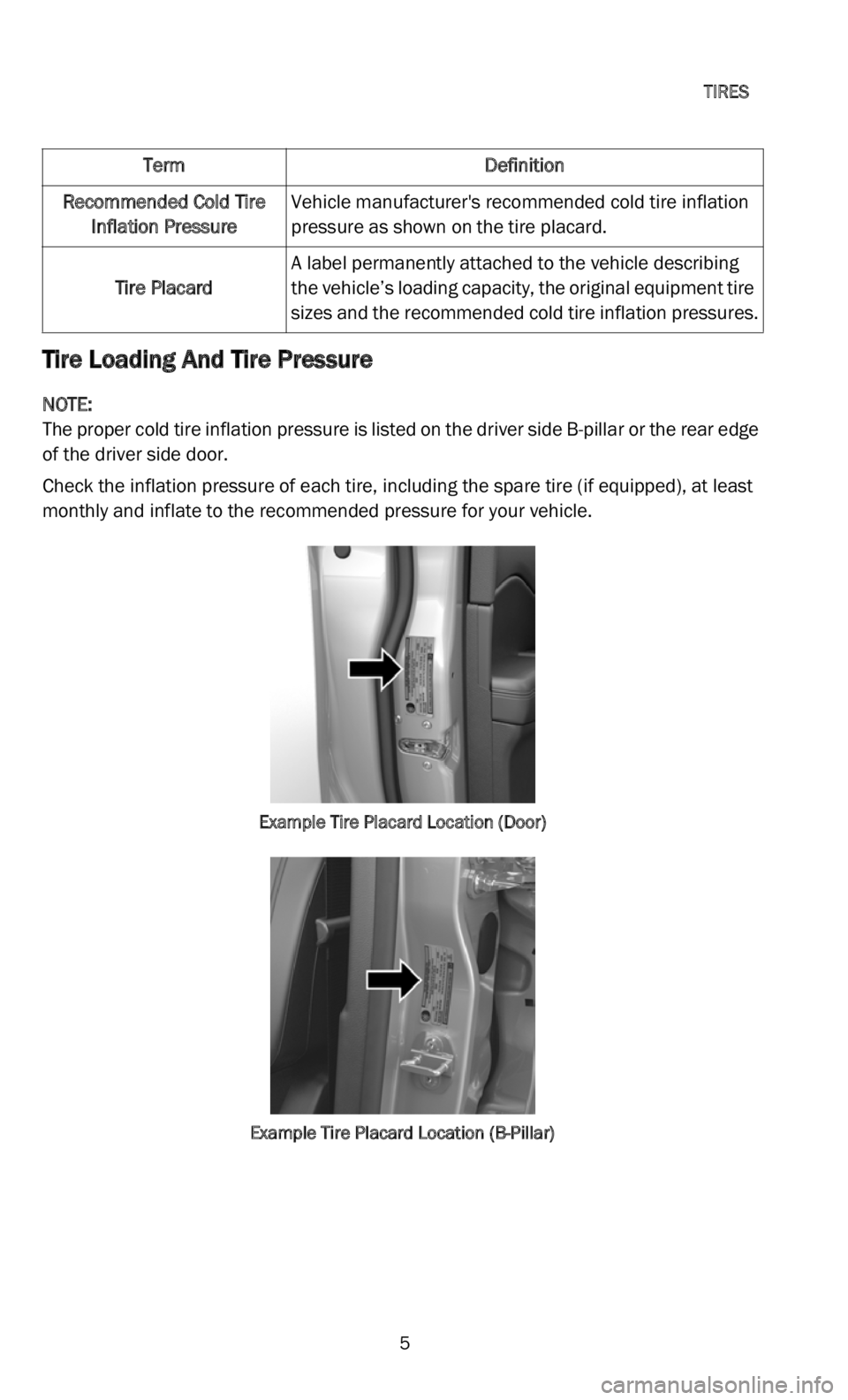
TIRES
5
Tire Loading And Tire Pressure
NOTE:
The proper cold tire inflation pressure is listed on the driver side B-pillar or the rear edge
of
the driver side door.
Check the inflation pressure of each tire, including the spare tire (if equipped), at least
mo n
thly and inflate to the recommended pressure for your vehicle.
Example Tire Placard Location (Door)
Example Tire Placard Location (B-Pillar)
Recommended Cold Tire Inflation Pressure Vehicle manufacturer's recommended cold tire inflation
pre
ssure as shown on the tire placard.
Tire Placard A label permanently attached to the vehicle describing
th
e
vehicle’s loading capacity, the original equipment tire
sizes and the recommended cold tire inflation pressures.
Term Definition
Page 7 of 200
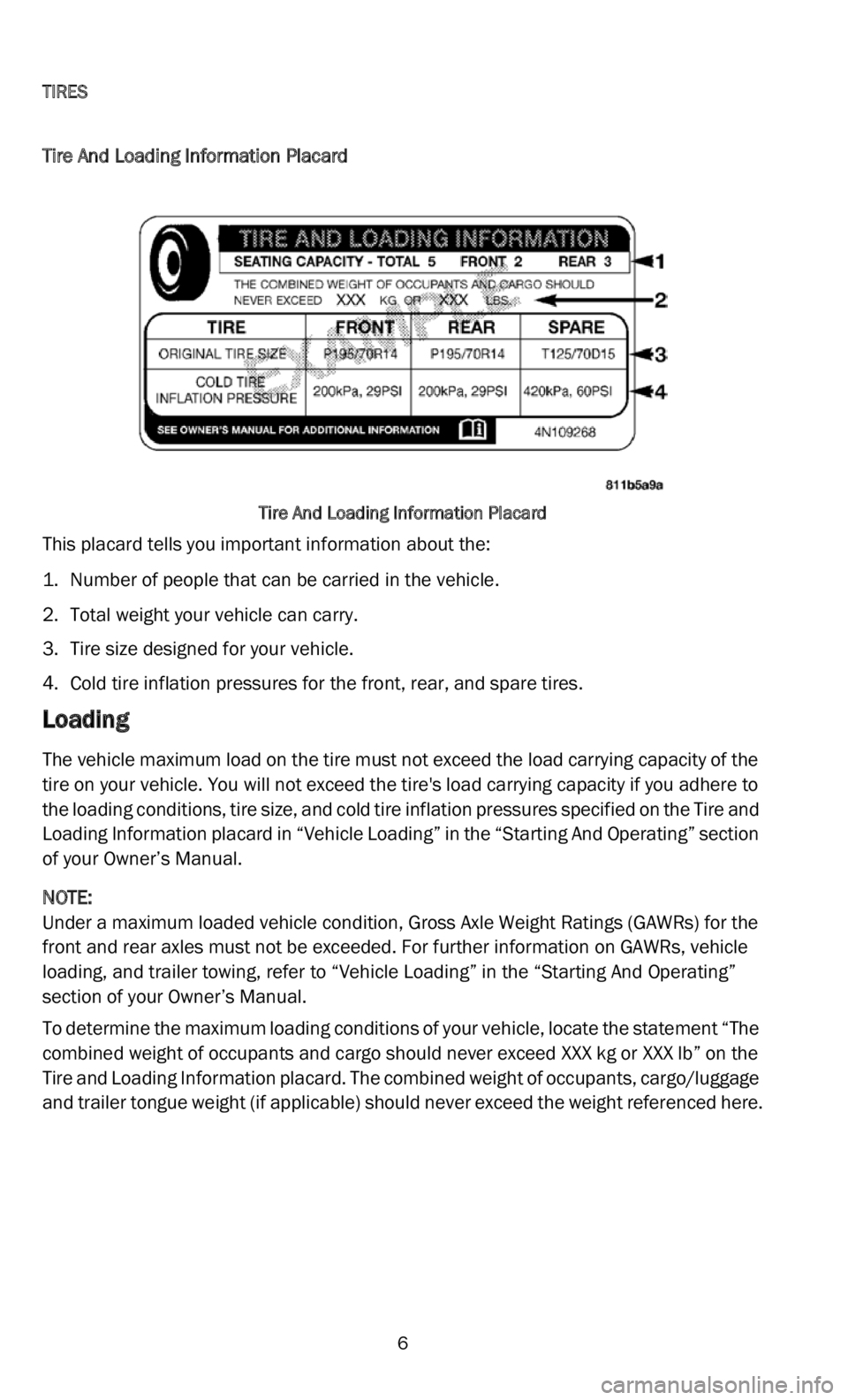
TIRES
6
Tire And Loading Information Placard
Tire And Loading Information Placard
This placard tells you important information about the:
1. Number of people that can be carried in the vehicle.
2.
Total weight your vehicle can carry.
3 .
Tire size designed for your vehicle.
4 .
Cold tire inflation pressures for the front, rear, and spare tires.
Loading
The vehicle maximum load on the tire must not exceed the load carrying capacity of the
tire on your vehicle. You will not exceed the tire's load carrying capacity if you adhere to
the loading conditions, tire size, and cold tire inflation pressures specified on the Tire and
Loading Information placard in “Vehicle Loading” in the “Starting And Operating” section
of your Owner’s Manual.
NOTE:
Under a maximum loaded vehicle condition, Gross Axle Weight Ratings (GAWRs) for the
f r o
nt and rear axles must not be exceeded. For further information on GAWRs, vehicle
loading, and trailer towing, refer to “Vehicle Loading” in the “Starting And Operating”
section of your Owner’s Manual.
To determine the maximum loading conditions of your vehicle, locate the statement “The
co m
bined weight of occupants and cargo should never exceed XXX kg or XXX lb” on the
Tire and Loading Information placard. The combined weight of occupants, cargo/luggage
and trailer tongue weight (if applicable) should never exceed the weight referenced here.
Page 8 of 200

TIRES
7
Steps For Determining Correct Load Limit—
(1) Locate the statement “The combined weight of occupants and cargo should never
ex c
eed XXX kg or XXX lb” on your vehicle's placard.
(2) Determine the combined weight of the driver and passengers that will be riding in
yo u
r vehicle.
(3) Subtract the combined weight of the driver and passengers from XXX kg or
XXX lb.
(4) The resulting figure equals the available amount of cargo and luggage load capacity.
Fo r
example, if “XXX” amount equals 1,400 lb and there will be five 150 lb passengers
in your vehicle, the amount of available cargo and luggage load capacity is 650 lb
(1,400-750 (5x150) = 650 lb).
(5) Determine the combined weight of luggage and cargo being loaded on the vehicle.
Th a
t weight may not exceed the available cargo and luggage load capacity calculated in
Step 4.
(6) If your vehicle will be towing a trailer, the load from your trailer will be transferred to
yo u
r vehicle. Consult this manual to determine how this reduces the available cargo and
luggage load capacity of your vehicle.
Metric Example For Load Limit
For example, as shown in step 4 above, if “XXX” amount equals 635 kg and there will be
fi v
e 68 kg passengers in your vehicle, the amount of available cargo and luggage load
capacity is 295 kg (635-340 (5x68) = 295 kg).
NOTE:
• If your vehicle will be towing a trailer, the load from your trailer will be transferred to yo
ur vehicle. The following table shows examples on how to calculate total load,
cargo/luggage, and towing capacities of your vehicle with varying seating configura -
tions and number and size of occupants. This table is for illustration purposes only and
ma y
not be accurate for the seating and load carrying capacity of your vehicle.
• For the following example, the combined weight of occupants and cargo should never ex
ceed 865 lb (392 kg).
Page 9 of 200
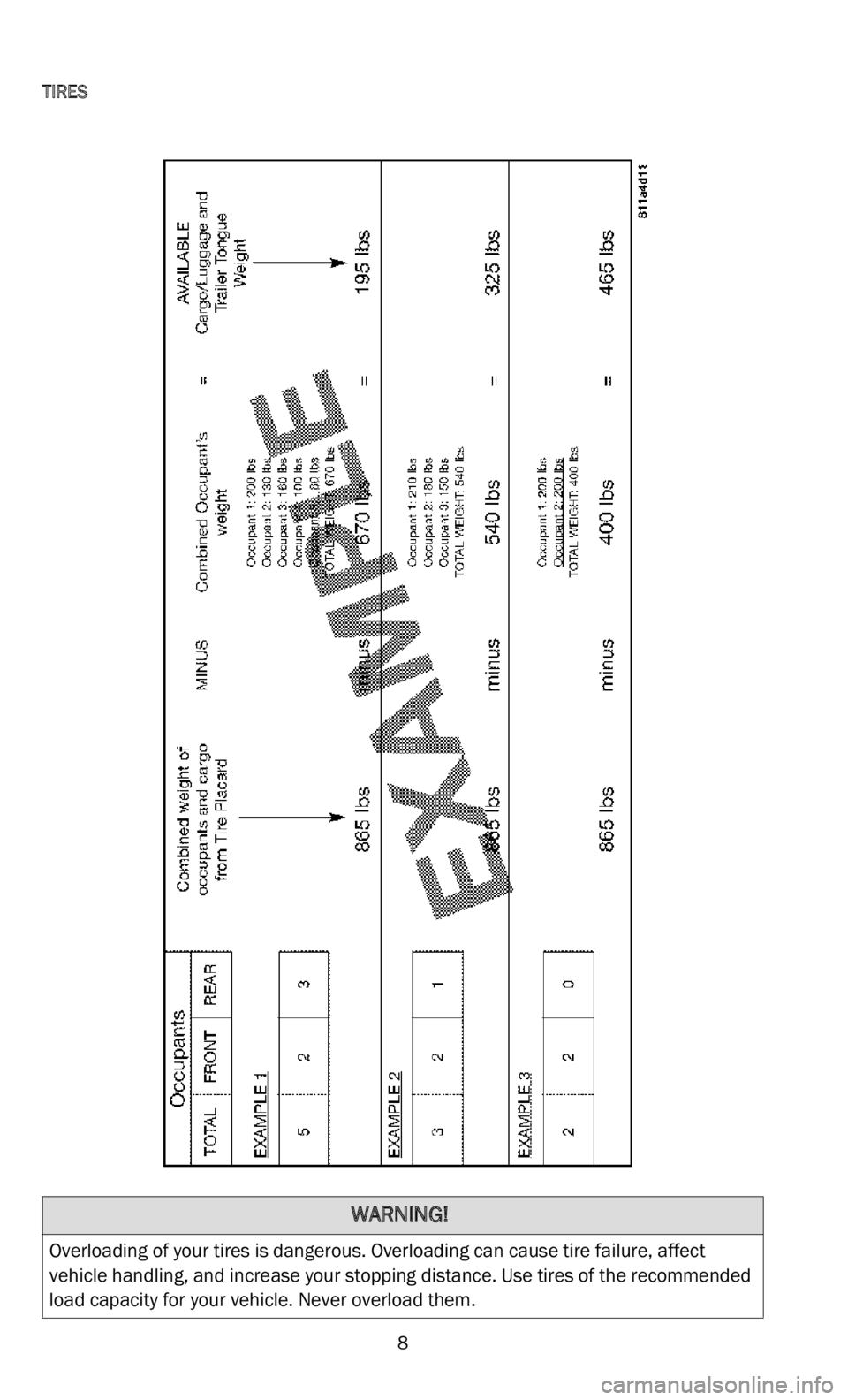
TIRES
8
WARNING!
Overloading of your tires is dangerous. Overloading can cause tire failure, affect
vehicle handling, and increase your stopping distance. Use tires of the recommended
load capacity for your vehicle. Never overload them.
Page 12 of 200
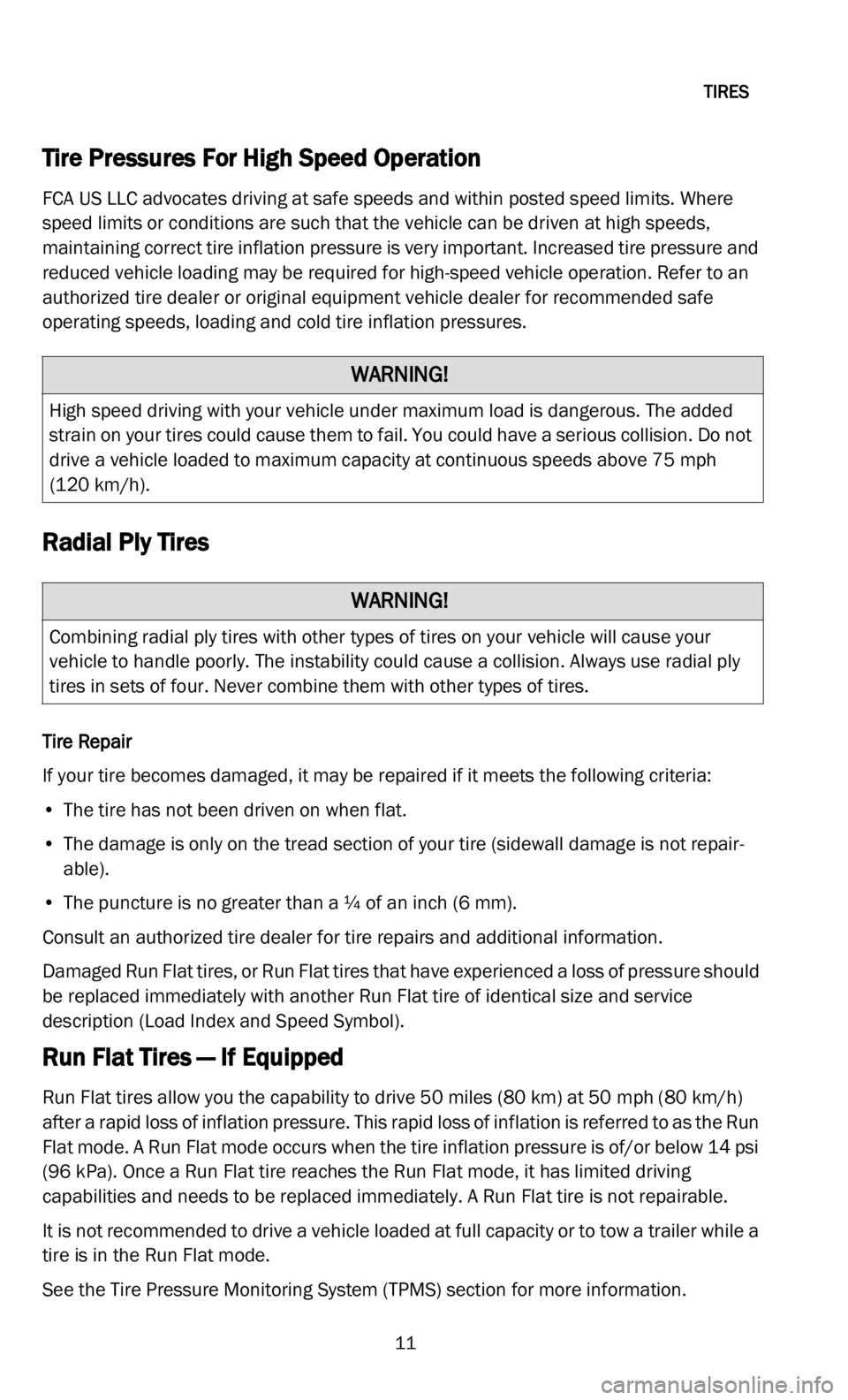
TIRES
11
Tire Pressures For High Speed Operation
FCA US LLC advocates driving at safe speeds and within posted speed limits. Where
speed limits or conditions are such that the vehicle can be driven at high speeds,
maintaining correct tire inflation pressure is very important. Increased tire pressure and
reduced vehicle loading may be required for high-speed vehicle operation. Refer to an
authorized tire dealer or original equipment vehicle dealer for recommended safe
operating speeds, loading and cold tire inflation pressures.
Radial Ply Tires
Tire Repair
If your tire becomes damaged, it may be repaired if it meets the following criteria:
• The tire has not been driven on when flat.
• Th
e damage is only on the tread section of your tire (sidewall damage is not repair -
a b
le).
• The puncture is no greater than a ¼ of an inch (6 m
m).
Consult an authorized tire dealer for tire repairs and additional information.
Damaged Run Flat tires, or Run Flat tires that have experienced a loss of pressure should
be
replaced immediately with another Run Flat tire of identical size and service
description (Load Index and Speed Symbol).
Run Flat Tires — If Equipped
Run Flat tires allow you the capability to drive 50 miles (80 km) at 50 mph (80 km/h)
aft
er a rapid loss of inflation pressure. This rapid loss of inflation is referred to as the Run
Flat mode. A Run Flat mode occurs when the tire inflation pressure is of/or below 14 psi
(96 kPa). Once a Run Flat tire reaches the Run Flat mode, it has limited driving
capabilities and needs to be replaced immediately. A Run Flat tire is not repairable.
It is not recommended to drive a vehicle loaded at full capacity or to tow a trailer while a
tir
e is in the Run Flat mode.
See the Tire Pressure Monitoring System (TPMS) section for more information.
WARNING!
High speed driving with your vehicle under maximum load is dangerous. The added
strain on your tires could cause them to fail. You could have a serious collision. Do not
drive a vehicle loaded to maximum capacity at continuous speeds above 75 mph
(1 2
0 km/h).
WARNING!
Combining radial ply tires with other types of tires on your vehicle will cause your
vehicle to handle poorly. The instability could cause a collision. Always use radial ply
tires in sets of four. Never combine them with other types of tires.
Page 15 of 200
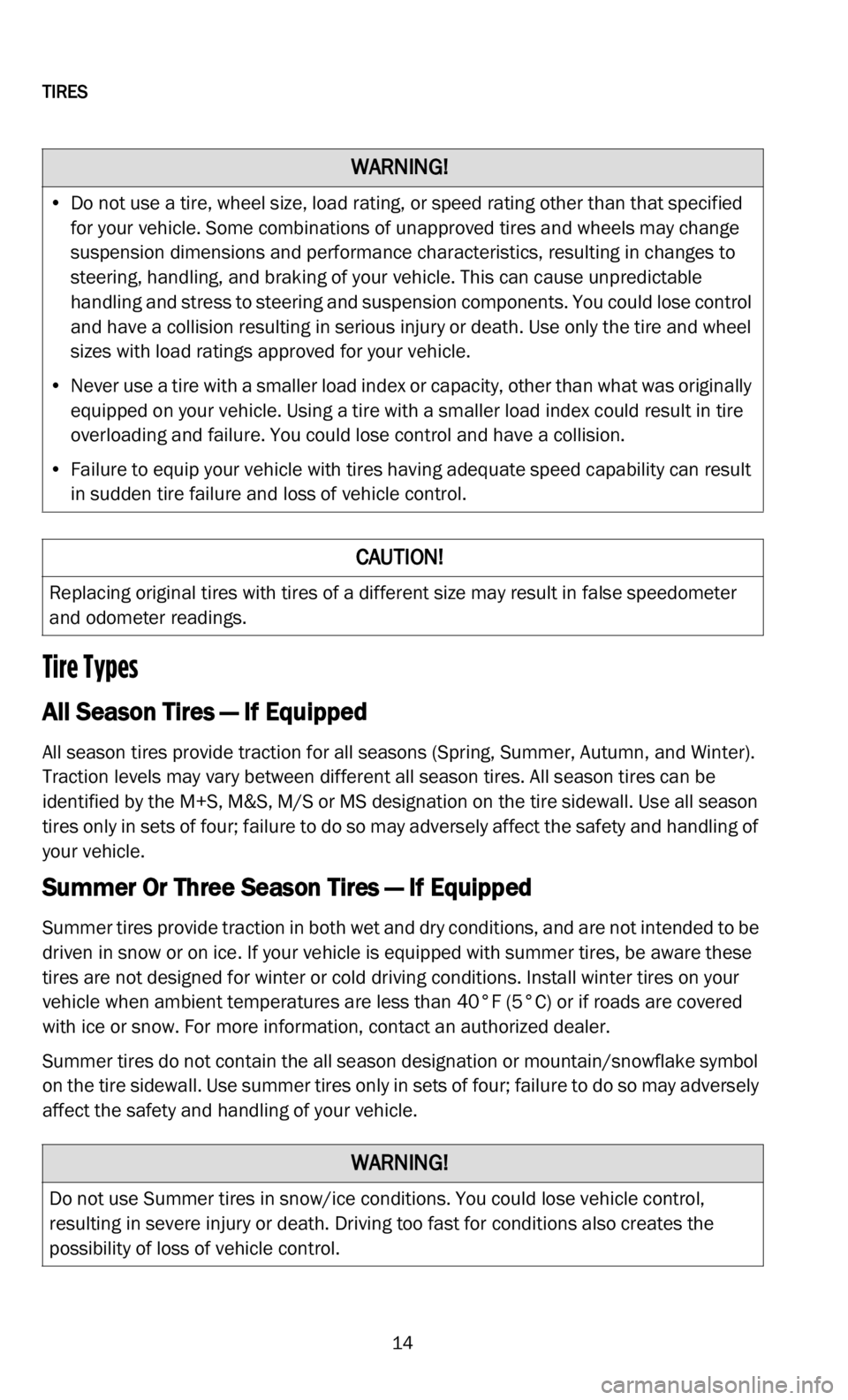
TIRES
14
Tire Types
All Season Tires — If Equipped
All season tires provide traction for all seasons (Spring, Summer, Autumn, and Winter).
Traction levels may vary between different all season tires. All season tires can be
identified by the M+S, M&S, M/S or MS designation on the tire sidewall. Use all season
tires only in sets of four; failure to do so may adversely affect the safety and handling of
your vehicle.
Summer Or Three Season Tires — If Equipped
Summer tires provide traction in both wet and dry conditions, and are not intended to be
driven in snow or on ice. If your vehicle is equipped with summer tires, be aware these
tires are not designed for winter or cold driving conditions. Install winter tires on your
vehicle when ambient temperatures are less than 40°F (5°C) or if roads are covered
with ice or snow. For more information, contact an authorized dealer.
Summer tires do not contain the all season designation or mountain/snowflake symbol
on
the tire sidewall. Use summer tires only in sets of four; failure to do so may adversely
affect the safety and handling of your vehicle.
WARNING!
• Do not use a tire, wheel size, load rating, or speed rating other than that specified for your vehicle. Some combinations of unapproved tires and wheels may change
suspension dimensions and performance characteristics, resulting in changes to
steering, handling, and braking of your vehicle. This can cause unpredictable
handling and stress to steering and suspension components. You could lose control
and have a collision resulting in serious injury or death. Use only the tire and wheel
sizes with load ratings approved for your vehicle.
• Never use a tire with a smaller load index or capacity, other than what was originally eq
uipped on your vehicle. Using a tire with a smaller load index could result in tire
overloading and failure. You could lose control and have a collision.
• Failure to equip your vehicle with tires having adequate speed capability can result in
sudden tire failure and loss of vehicle control.
CAUTION!
Replacing original tires with tires of a different size may result in false speedometer
and odometer readings.
WARNING!
Do not use Summer tires in snow/ice conditions. You could lose vehicle control,
resulting in severe injury or death. Driving too fast for conditions also creates the
possibility of loss of vehicle control.
Page 27 of 200

BFGOODRICH® TIRES
26
SPEED RATINGS
Speed Symbols are shown on the sidewall of some BFGoodrich® tires. The following
table shows the maximum speed corresponding to the symbol.
*Some V (or VR) rated tires may have a speed capacity greater than 149 mph (240 km/h).
C o
nsult your participating BFGoodrich® tire retailer for maximum speed rating if your
vehicle capability exceeds this speed.
**Z (or ZR) rated tires are designed to be used on cars with maximum speed capabilities
i n
excess of 149 mph (240 km/h).
W and Y speed ratings are sub-categories of Z.
Consult your BFGoodrich® tire retailer for maximum speed capabilities.
Although a tire may be speed-rated, we do not endorse the operation of any vehicle in an
u n
safe or unlawful manner. Speed ratings are based on laboratory tests which relate to
performance on the road, but are not applicable if tires are underinflated, overloaded,
worn out, damaged, altered, improperly repaired, or retreaded. Furthermore, a tire’s
speed rating does not imply that vehicles can be safely driven at the maximum speed for
which the tire is rated, particularly under adverse road and weather conditions or if the
vehicle has unusual characteristics.
BFGoodrich® highway passenger tires that do not have a speed symbol on the sidewall
h a
ve a maximum speed rating of 105 mph (170 km/h). Light truck highway tires that do
n o
t have a speed symbol on the sidewall of the tire have a maximum speed rating of
87 mph (140 km/h).
The speed and other ratings of retreaded tires are assigned by the retreader and replace
t h
e original manufacturer’s ratings.
NOTE:
In order to maintain the speed capability of the vehicle, replacement tires must have
s p
eed ratings equal to or higher than those fitted as original equipment as indicated on
the vehicle tire placard or Owner’s Manual. If tires with lower speed ratings are fitted, the
vehicle’s handling may be affected and the speed capability of the vehicle will be lowered
to the maximum speed capability of the replacement tires as indicated in the following
table.
SPEED Ratings Maximum Speed
Km/h mph
M 130 81
N 140 87
P 150 93
Q 160 100
R 170 106
S 180 112
Page 58 of 200

BRIDGESTONE® - FIRESTONE®
57
RFT Tire Replacement
Do not replace or mix RFT tires with conventional tires, unless on an emergency/
t e
mporary basis. Conventional tires do not have run-flat capability and the handling
characteristics of the vehicle with these tires may be different. If a conventional tire is
used on an emergency/temporary basis, verify that its size, load capacity, inflation
pressure, and speed rating specifications meet the requirements of the vehicle. Replace
any conventional tire with the proper RFT tire as soon as possible.
RFT Tire Damage and Repair
No tire, regardless of its design or quality is indestructible. RFT tires can be ultimately
r e
ndered unusable due to a puncture or other road hazard as well as from improper
run-flat or low tire pressure operation. Some punctures may be repaired under certain
restrictions and prescribed procedures.
When driven flat or with low pressure, factors affecting reparability include vehicle speed,
l o
ad, and maneuvering; the amount of inflation pressure loss; and ambient temperature.
In any situation, the extent and location of direct damage from a puncturing object or
other road hazard are also critical factors.
RFT tires are not repairable in any of the following situations:
• I f the tire was operated with inflation pressure less than 15 psi (100 kPa).
•
Abrasion or other damage is present on the exterior tread, sidewall or bead areas.
•
Abrasion, wrinkling, or separation is present on the tire interior.
•
Any condition or damage is present that disqualifies repair of a conventional tire.
R
un-Flat Certified Retailers will fully inspect your tire, inside and out, to determine if the
t i
re can be repaired. Tire damage is not always visible from the outside and the tire must
be removed from the wheel for a complete inspection. For more information, see the
section “Tire Repairs” in this manual.
NOTE:
Some vehicle manufacturers do not recommend using repaired tires. Consult your
v e
hicle Owner’s Manual or contact the vehicle manufacturer before operating a repaired
tire on your vehicle.
Page 60 of 200
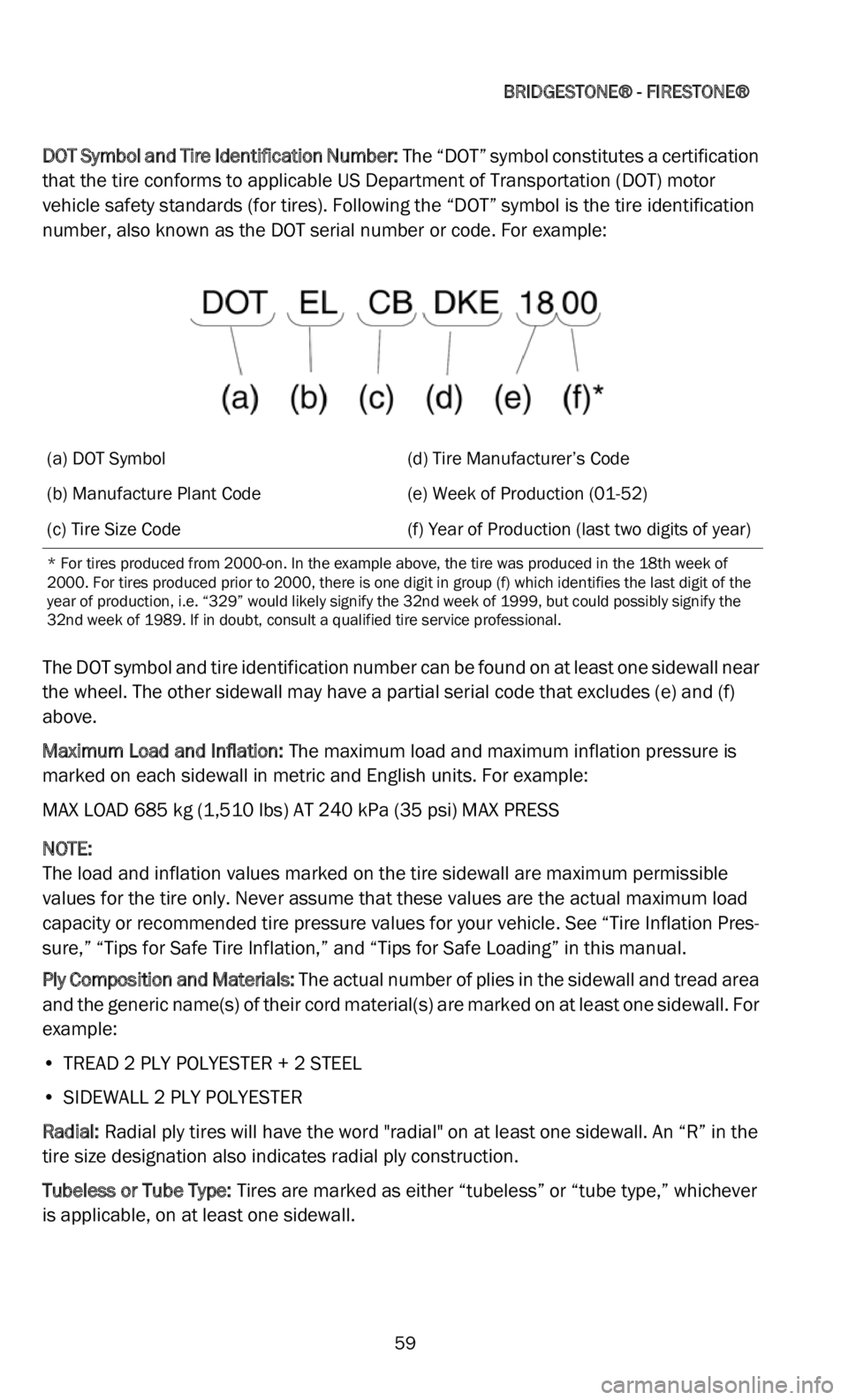
BRIDGESTONE® - FIRESTONE®
59
DOT Symbol and Tire Identification Number: The “DOT” symbol constitutes a certification
that the tire conforms to applicable US Department of Transportation (DOT) motor
vehicle safety standards (for tires). Following the “DOT” symbol is the tire identification
number, also known as the DOT serial number or code. For example:
The DOT symbol and tire identification number can be found on at least one sidewall near
th
e wheel. The other sidewall may have a partial serial code that excludes (e) and (f)
above.
Maximum Load and Inflation: T
he maximum load and maximum inflation pressure is
marked on each sidewall in metric and English units. For example:
MAX LOAD 685 kg (1,510 lbs) AT 240 kPa (35 psi) MAX PRESS
NOTE:
The load and inflation values marked on the tire sidewall are maximum permissible
v a
lues for the tire only. Never assume that these values are the actual maximum load
capacity or recommended tire pressure values for your vehicle. See “Tire Inflation Pres -
sure,” “Tips for Safe Tire Inflation,” and “Tips for Safe Loading” in this manual.
Ply Composition and Materials: T
he actual number of plies in the sidewall and tread area
and the generic name(s) of their cord material(s) are marked on at least one sidewall. For
example:
• T READ 2 PLY POLYESTER + 2 STEEL
•
SIDEWALL 2 PLY POLYESTER
R
adial: Radial ply tires will have the word "radial" on at least one sidewall. An “R” in the
t
ire size designation also indicates radial ply construction.
Tubeless or Tube Type: T
ires are marked as either “tubeless” or “tube type,” whichever
is applicable, on at least one sidewall.
(a) DOT Symbol (d) Tire Manufacturer’s Code
(b) Manufacture Plant Code (e) Week of Production (01-52)
(c) Tire Size Code (f) Year of Production (last two digits of year)
* For tires produced from 2000-on. In the example above, the tire was produced in the 18th week of
2000. For tires produced prior to 2000, there is one digit in group (f) which identifies the last digit of the
year of production, i.e. “329” would likely signify the 32nd week of 1999, but could possibly signify the
32nd week of 1989. If in doubt, consult a qualified tire service professional.
Page 64 of 200

BRIDGESTONE® - FIRESTONE®
63
WHERE TO GO
Tire adjustments under this Limited Warranty will only be made at an authorized
Bridgestone® Firestone® retailer. Consult a phone directory (often listed in the Yellow
Pages under "Tire Dealers") or the internet at www.bridgestonetire.com for the location
nearest you.
CONSUMER RIGHTS
This Limited Warranty gives you specific legal rights, and you may also have other rights
which vary in the United States from state to state or in Canada from province to
province.
CONDITIONS AND EXCLUSIONS
To the extent permitted by law, Bridgestone® Firestone® North American Tire, LLC
disclaims all other warranties, including but not limited to the implied warranties of
merchantability and fitness for a particular purpose and any liability for incidental and
consequential damages, loss of time, loss of vehicle use, or inconvenience. Some states
do not allow the exclusion or limitation of incidental or consequential damages, so the
above limitation or exclusion may not apply to you.
This Limited Warranty applies only to consumers actually using the tire in the United
S t
ates and Canada. For warranty conditions outside the United States and Canada, see
your local Bridgestone® Firestone® distributor.
Obligations under this policy may not be enlarged or altered by anyone.
In accordance with Federal Law, this Limited Warranty has been designated as a "Limited
W a
rranty.” Nothing in this Limited Warranty is intended to be a representation that tire
failures cannot occur. This Limited Warranty is given in the United States by
Bridgestone® Firestone® North American Tire, LLC, 535 Marriott Dr., Nashville, TN
37214 and in Canada by Bridgestone® Firestone® Canada Inc., 5770 Hurontario St.,
Suite 400, Mississauga, Ontario, Canada L5R 3G5.
OWNER’S OBLIGATIONS
In order to keep this Limited Warranty valid, we require you to have your tires regularly
inspected and rotated per the recommendations outlined in the sections of this manual
entitled "Tire Damage, Inspection and Service Life” and “Radial Tire Rotation” and to
furnish proof of same in order to receive an adjustment. Such proof should show the
date, mileage, and servicing location. A sales receipt containing this information will
suffice. In addition, a “Maintenance Record” is included on the back cover of this
manual. It is your obligation to maintain proper tire inflation pressures as specified by the
vehicle manufacturer and to operate the vehicle within tire/vehicle load capacity and
speed limitations. It is also your obligation to maintain proper wheel alignment and tire/
wheel assembly balance. To request an adjustment, you must present the tire to an
authorized Bridgestone® Firestone® retailer. Complete and sign the customer section
of the Bridgestone® Firestone® North American Tire, LLC Limited Warranty adjustment
form and pay appropriate replacement price, taxes, disposal fee, and service charges, if
any.